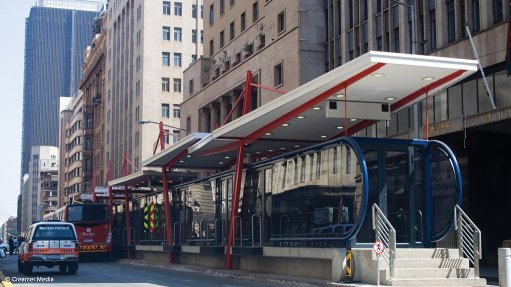
Rea Vaya
Photo by: Duane Daws
The Department of Transport (DoT) has allocated R5.5-billion in the current financial year to plan, build and operate integrated public transport networks in 13 cities.
Presenting the DoT budget for the 2014/15 financial year, Transport Minister Dipuo Peters outlined the department’s budget allocation for the 2014/15 financial year of R48.7-billion.
The DoT proposed allocating R20.1-billion – over 41% of the overall budget – to provinces and municipalities, while R14.9-billion would be dispersed to public corporations and private enterprises, and R12.2-billion to agencies.
“Our approach is also to support the implementation of the National Development Plan’s priorities of maintaining road infrastructure, upgrading rail infrastructure and services [and] building and operating public transportation infrastructure for our people,” she said during her budget vote presentation to Parliament.
With rapidly urbanising economies, an opportunity had emerged for the roll-out of “safer, cleaner and more affordable” transport systems, while reducing congestion, facilitating access to jobs and lowering energy consumption in the transport sector.
“In emerging cities, where most of the new urban dwellers live, city planners have an opportunity to design sustainable and inclusive transport system from the start, leapfrogging more polluting and costly modes,” Peters explained.
Older, larger cities could leverage technology and data management to better map travel patterns and needs, engage citizens and improve the quality and efficiency of transport solutions.
Peters pointed to the extensive development of rapid transport systems across the country, with bus rapid transit (BRT) systems set to make an entrance in eThekwini, Rustenburg, Polokwane, Nelspruit and George, as well as the Nelson Mandela Metropolitan as the Ibhongo-Lethu BRT system was finalised.
The DoT had rolled out BRT systems across Gauteng, including Rea Vaya, in Johannesburg, and Areyeng, in Tshwane, as well as in the Western Cape, where the MyCiTi BRT system was introduced in Cape Town.
In KwaZulu-Natal, the department built the Bridge City multimodal public transport facility to “create a nucleus” for a multisectoral transport approach.
RAIL AMBITIONS
The DoT was also currently revamping legacy rolling stock, outdated signaling technology and dilapidated railway stations, with more than 50 universally accessible stations, as well as 2 600 modern coaches built, upgraded or refurbished.
The new rolling stock fleet-renewal programme for the Passenger Rail Agency of South Africa was well under way with the procurement process concluded.
The Gibela consortium would supply 198 coaches over the next three years, as part of the overall contract to supply 3 600 new coaches over the next ten years.
“The first modern set of trains is expected to hit our tracks in 2015,” she said.
Further, Gibela planned to build a R1-billion, 600 000 m2 coach building and locomotive assembly plant in Dunnottar, on the East Rand, to produce the 580 locally manufactured trains.
“Through 65% localisation we will realise the creation of 33 000 direct and indirect jobs, [and the] training of 19 000 technicians, artisans, engineers and train drivers,” Peters pointed out.
Meanwhile, with the completion of a feasibility study on the infamous R573 Moloto road, which carried some 35 000 commuters a day from Mpumalanga into the Tshwane metropolitan and Johannesburg and back, the department had gained some traction in the implementation of an integrated rapid rail option on the “important” Moloto Corridor.